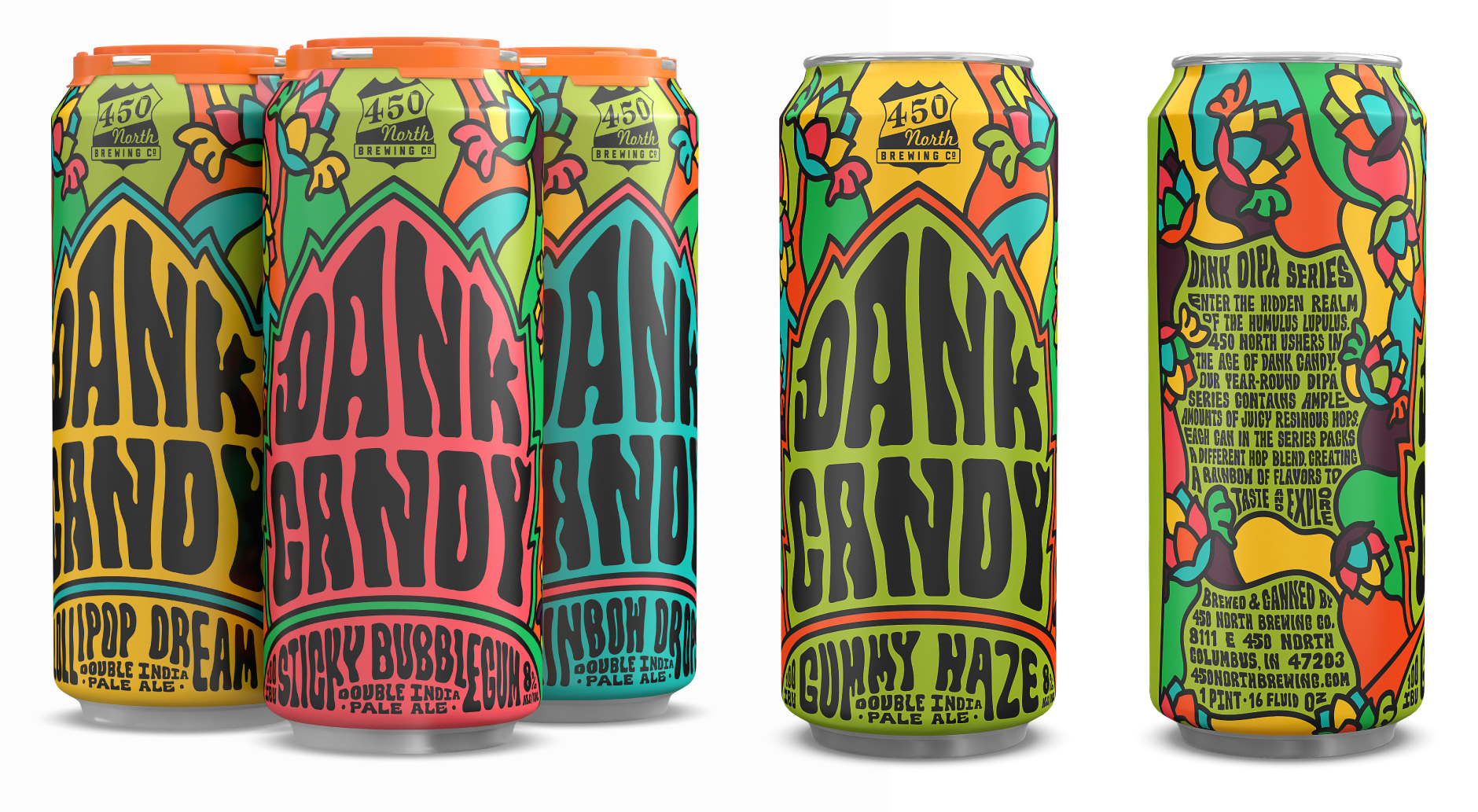GETTING BEER LABELS APPROVED CAN BE A PAINFUL PROCESS IF YOU DON’T KNOW WHAT YOU’RE DOING. HERE ARE a few pointers to MAKE IT GO SMOOTHLY.
To start, the TTB, or Alcohol and Tobacco Tax and Trade Bureau, is the federal gatekeeper for approving beer packaging, among other things. It’s kind of like the X-Files, but with more of a focus on beer and less sardonic wit. And markedly less Scully. Actually, it’s nothing like the X-Files. Sorry.
Basically, the TTB specifies what you can and can’t put on your beer label. This covers everything from the art itself, down to what type size you can use, what verbiage can be included, where to place certain elements, and so forth.

Some of our specialty can designs for 450 North Brewing Co.
Our first time designing beer labels was eye-opening because we made something that we and our client loved. The client then submitted it to the TTB and several weeks later, we got dinged with a laundry list of edits. Some of them made common sense, and some of them were, well… peculiar. Let’s discuss some of the issues we’ve run into to see if we save you some headache, shall we?
Here are some insights we’ve gleaned to help you navigate the process.
-
1
Make sure to factor the TTB’s backlog into your project timeline
Before designing anything, you need to understand that this approval process can completely kill your timeline, both as a designer looking to make some beautiful cans and as a brewer, looking to can some great beer.
TTB is allowed up to 90 days to review your labels and while it doesn’t always take that long, it’s a safe benchmark for planning your label production and brewing timeline. You can find the current TTB backlog schedule at www.ttb.gov
We’ve found this waiting period is a good time to tackle other design pieces so you’re not sitting on your hands.
-
2
Read, reread and re-re-read the TTB Guidelines
This probably goes without saying, but you need to download and thoroughly review the TTB’s guidelines.
This is a good way to figure out the larger components of your label requirements, like how to list your beer’s style, ABV, brewery location, government warnings, and so forth.
-
3
GET OUT AHEAD OF THE VOLUNTARY DISCLOSURE INITIATIVE
While not mandatory yet, there is currently a push to get all breweries to include caloric and nutritional info, alcohol content, ingredients, and a “born-on date” on their packaging or website. We’ll see some best practices emerge over the next few years, but for now, you can jump ahead of the curve and include it from the start. Learn more here.
-
4
ORIENT YOURSELF WITH CURRENT, ON-THE-MARKET LABELS
Before designing your labels, buy several varieties of whatever it is you’re designing (12 ounce bottles, 22 ounce bombers, 16 ounce cans, etc.) to review. This will give you a good sense of packaging that’s on the market and has ostensibly survived the TTB’s horrible maw.
Then, you should drink these, because toting around a bunch of full cans and/or bottles is silly and expends way more energy than necessary. Gotta conserve calories in this economy. That’s a pro tip, from CODO, to you.
Click here to learn more about current craft beer branding trends.
-
5
Don’t limit your label design
This is aimed at designers who are looking through the dozens of pages of TTB guidelines with a sense of dread: You should view these rules more as parameters (or a checklist) than a roadblock. Consider overall positioning and branding, and design the hell out of those things. Remember, you’ll be duking it out with countless other brands out in the wild—make it count.
-
6
Save your actual TTB submission files correctly
We almost included this nugget with one of the earlier points, but it’s so important that it warrants its own section. As of this writing (please confirm this on your own, as it changes), the TTB is requiring that submitted files be less than 750kb in size, and saved as RGB color mode Jpegs. (Apparently, the TTB reviews these files on a Jitterbug flip phone.)
If you don’t do this, it means more time waiting for approval. Look, we don’t make the rules here. Just give them what they want and back away slowly.
-
7
BE PREPARED FOR SMALL, HAIR-PULLING EDITS AND THE ADDITIONAL APPROVAL TIME they require
At the risk of sounding pessimistic, make sure to factor in extra time for revisions. No matter how carefully we, our brewery clients, and their lawyers review label submissions, there’s always a chance that the TTB will find something to push back on. Build in an extra week or two to make these changes if you’re looking ahead to purchasing labels or brewing the beer itself.
HERE ARE SOME ADDITIONAL TTB RESOURCES
TTB’s site has a thorough FAQ section.

Kros Strain Brewing (Omaha, NE) came to market with a mix of 12oz bottles and bombers. Format changes like this call for subtle differences in how you list ABV and other crucial info for TTB approval.

